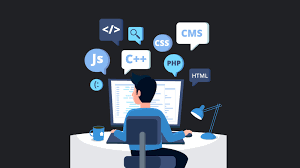The Art and Science of Software Development
Software development is both an art and a science that plays a crucial role in shaping the modern world. It involves the process of designing, creating, testing, and maintaining software applications that solve specific problems or meet particular needs.
The Software Development Lifecycle
Software development follows a structured approach known as the Software Development Lifecycle (SDLC). This lifecycle typically includes stages such as requirements gathering, design, implementation, testing, deployment, and maintenance.
Key Concepts in Software Development
One fundamental concept in software development is programming languages. Developers use languages like Java, Python, C++, and others to write code that instructs computers on how to perform tasks.
Another essential aspect is algorithm design. Algorithms are step-by-step procedures or formulas for solving problems. Efficient algorithms are crucial for optimizing software performance.
The Role of Developers
Software developers are the creative minds behind software applications. They work closely with stakeholders to understand requirements and translate them into functional code. Developers must possess strong problem-solving skills and attention to detail.
Trends in Software Development
As technology advances, new trends emerge in software development. These include Agile methodologies for faster delivery, DevOps practices for seamless collaboration between development and operations teams, and cloud computing for scalable and flexible infrastructure.
Conclusion
In conclusion, software development is a dynamic field that continues to evolve with the changing technological landscape. By embracing best practices, staying updated on industry trends, and fostering innovation, developers can create impactful solutions that drive progress and innovation.
Essential FAQs About Software Development: Understanding Processes, Languages, and Skill Enhancement
- What is software development?
- What are the different programming languages used in software development?
- What is the difference between frontend and backend development?
- How does the Agile methodology benefit software development projects?
- What are the key steps involved in the Software Development Lifecycle (SDLC)?
- How can I improve my skills as a software developer?
What is software development?
Software development refers to the process of creating, designing, implementing, and maintaining software applications to address specific needs or solve particular problems. It involves a systematic approach that encompasses various stages such as requirements gathering, coding, testing, and deployment. Software development requires a combination of technical skills, creativity, problem-solving abilities, and collaboration to deliver high-quality solutions that meet the demands of users and businesses. It is a multifaceted discipline that plays a crucial role in shaping the digital landscape and driving innovation across industries.
What are the different programming languages used in software development?
In software development, various programming languages are utilized to write code and create applications tailored to specific requirements. The choice of programming language depends on factors such as the nature of the project, desired functionality, and developer expertise. Common programming languages include Java, known for its versatility and platform independence; Python, valued for its readability and ease of use; C++, favored for its performance and system-level programming capabilities; and JavaScript, widely used for web development due to its compatibility with browsers. Each language has its strengths and is selected based on the project’s needs to ensure efficient and effective software development.
What is the difference between frontend and backend development?
In software development, the difference between frontend and backend development lies in their respective roles and responsibilities. Frontend development focuses on the user interface and user experience of a software application, dealing with what users see and interact with directly. It involves creating visually appealing layouts, responsive designs, and interactive elements using technologies like HTML, CSS, and JavaScript. On the other hand, backend development involves working on the server-side of an application, handling data processing, server configuration, database management, and ensuring the smooth functioning of the application’s logic behind the scenes. Backend developers typically use languages such as Python, Java, or PHP to build robust and scalable server-side components that support the frontend functionality. Both frontend and backend development are essential components of creating a well-rounded software application that delivers a seamless user experience.
How does the Agile methodology benefit software development projects?
The Agile methodology offers numerous benefits to software development projects by promoting iterative and incremental development, fostering collaboration among team members, and enhancing adaptability to changing requirements. Agile allows for continuous feedback loops, enabling teams to respond quickly to stakeholder input and make adjustments as needed. This approach also encourages transparency and communication, leading to improved project visibility and alignment with business goals. By breaking down complex projects into manageable tasks and delivering value in short iterations, Agile helps mitigate risks and ensures that the final product meets customer expectations effectively.
What are the key steps involved in the Software Development Lifecycle (SDLC)?
The Software Development Lifecycle (SDLC) encompasses several key steps that are essential for the successful development of software applications. These steps typically include requirements gathering, where the needs and objectives of the software project are defined; design, where the architectural and functional specifications are outlined; implementation, where the actual coding and programming take place; testing, to ensure that the software functions correctly and meets requirements; deployment, where the software is released to users; and maintenance, which involves ongoing updates, bug fixes, and enhancements to ensure the software remains effective and relevant over time. Each step in the SDLC is crucial in ensuring a systematic and well-structured approach to software development.
How can I improve my skills as a software developer?
To improve your skills as a software developer, it is essential to engage in continuous learning and practice. Stay updated with the latest technologies and trends in the industry by reading books, taking online courses, attending workshops, and participating in coding challenges. Practice coding regularly to enhance your problem-solving abilities and familiarize yourself with different programming languages and tools. Collaborate with other developers, seek feedback on your work, and actively participate in open-source projects to gain practical experience and expand your skill set. Remember that perseverance, dedication, and a growth mindset are key to becoming a proficient software developer.




